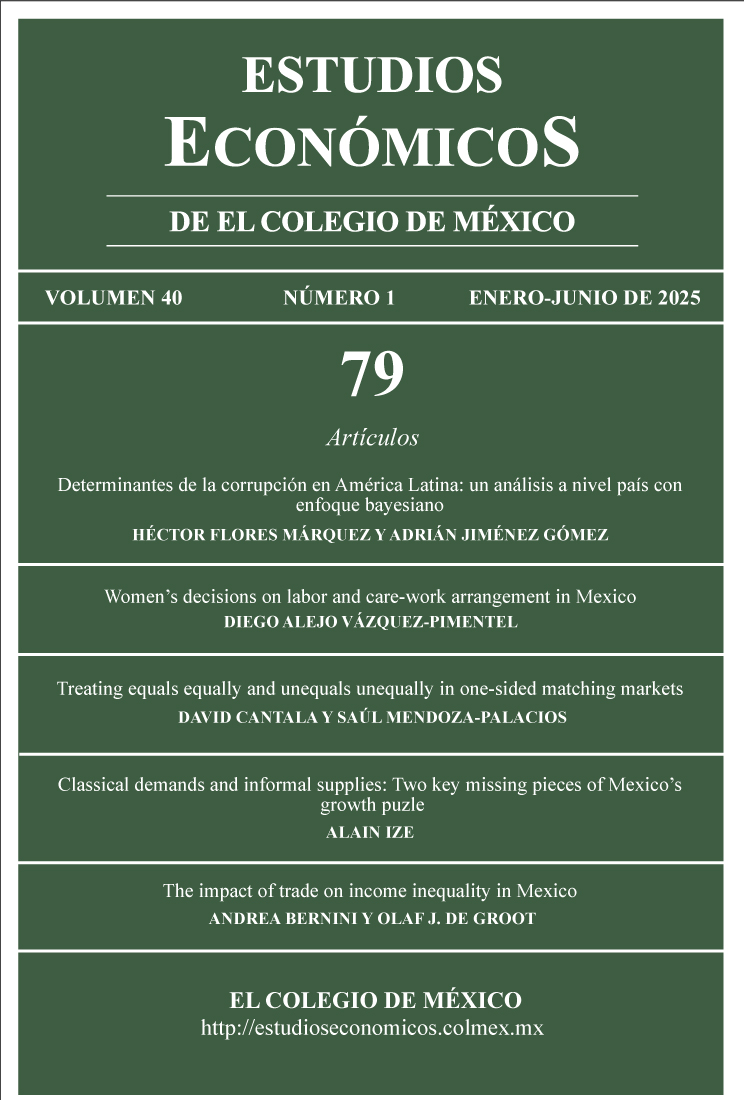Articles

Published 2025-03-26
Keywords
- one-sided matching,
- optimal transportation theory,
- Pareto optimality,
- core
How to Cite
Cantala, D., & Mendoza-Palacios, S. (2025). Treating equals equally and unequals unequally in one-sided matching markets. Estudios Económicos De El Colegio De México, 40(1), 1–12. https://doi.org/10.24201/ee.v40i1.e461
Abstract
We introduce in the one-sided assignment game by Shapley and Scarf (1974) the requirement called “Treating equals equally and unequal unequally” (TEEUU). We model an assignment as a measurable function that assigns a type of good to each type of agent. We establish: 1) a method, originated in optimal transportation theory, to find a TEEUU assignment in the core whenever it exists- by searching a Pareto optimal assignment- and 2) conditions under which a TEEUU assignment in the core always exists.
Downloads
Download data is not yet available.
References
- Abdulkadiroğlu, A. and T. Sönmez. 2003, School choice: A mechanism design approach, American Economic Review, 93(3): 729-747. DOI: https://doi.org/10.1257/000282803322157061
- Aumannn, R.J. 1964, Trading with a continuum of players, Econometrica, 32(1-2): 39-50. DOI: https://doi.org/10.2307/1913732
- Bridges, D.S. and G.B. Mehta. 2013. Representations of Preferences Orderings, Vol. 422, Springer.
- Carlier, G. 2003. Duality and existence for a class of mass transportation problems and economic applications, in S. Kusuoka and T. Maruyama (eds.), Advances in Mathematical Economics, Vol. 5, Springer. DOI: https://doi.org/10.1007/978-4-431-53979-7_1
- Debreu, G. 1954. Representation of a preference ordering by a numerical function, in M. Thrall, R.C. Davis, and C.H. Coombs (eds.), Decision Processes, New York, John Wiley and Sons.
- Echenique, F., N. Immorlica, and V. Vazirani. 2023. Online and Matching-Based Market Design, Cambridge University Press.
- Garg, J., T. Tröbust, and V. V. Vazirani. 2021. One-sided matching markets with endowments: equilibria and algorithms, Autonomous Agents and Multi-Agent Systems, 38: 40. DOI: https://doi.org/10.1007/s10458-024-09670-9
- Gretsky, N.E., J.M. Ostroy, and W.R. Zame. 1992. The nonatomic assignment model, Economic Theory, 2(1): 103-127. DOI: https://doi.org/10.1007/BF01213255
- Kaneko, M. and M.H. Wooders. 1986. The core of a game with a continuum of players and finite coalitions: The model and some results, Mathematical Social Science, 12(2): 105-137. DOI: https://doi.org/10.1016/0165-4896(86)90032-6
- Koopmans, T.C. and M. Beckmann. 1957. Assignment problems and the location of economic activities, Econometrica, 25(1): 53-76. DOI: https://doi.org/10.2307/1907742
- Kovalenkov, A. and M. Wooders. 2003. Aproximate cores of games and economies with clubs, Journal of Economic Theory, 110(1): 87-120. DOI: https://doi.org/10.1016/S0022-0531(03)00003-6
- Levin, V.L. 1983. A continuous utility theorem for closed preorders on a -compact metrizable space, Doklady Akademii Nauk, 28(3): 715-718.
- Levin, V.L. 2004. Optimal solutions of the Monge problem, in S. Kusuoka and T. Maruyama (eds.), Advances in Mathematical Economics, Vol. 6, Springer. DOI: https://doi.org/10.1007/978-4-431-68450-3_5
- Rachev, S.T. and L. Rüschendorf. 1998. Mass Transportation Problems. Volume I: Theory, Springer.
- Shapley, L. and H. Scarf. 1974. On cores and indivisibility, Journal of Mathematical Economics, 1(1): 23-37. DOI: https://doi.org/10.1016/0304-4068(74)90033-0

